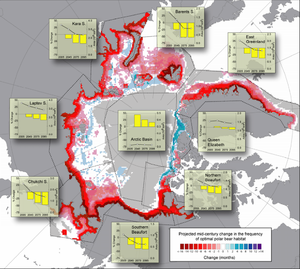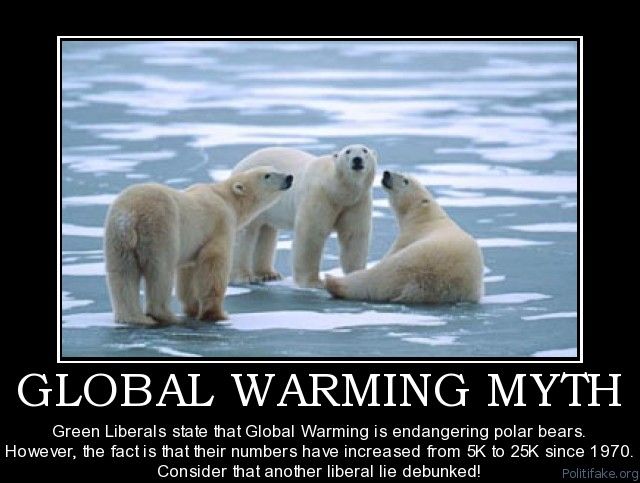How about if we consider it another denier lie? Good? Okay.
Population and distribution

Polar bears investigate the submarine
USS Honolulu 450 kilometres (280 mi) from the
North Pole.
The polar bear is found in the Arctic Circle and adjacent land masses as far south as
Newfoundland Island. Due to the absence of human development in its remote habitat, it retains more of its original range than any other
extant carnivore.
[30] While they are rare north of 88°, there is evidence that they range all the way across the Arctic, and as far south as
James Bay in Canada. Their southernmost range is near the boundary between the
subarctic and
humid continental climate zones. They can occasionally
drift widely with the sea ice, and there have been anecdotal sightings as far south as
Berlevåg on the Norwegian mainland and the
Kuril Islands in the
Sea of Okhotsk. It is difficult to estimate a global population of polar bears as much of the range has been poorly studied; however, biologists use a working estimate of about 20,000 to 25,000 polar bears worldwide.
[1][31]
There are 19 generally recognized, discrete subpopulations.
[31][32] The subpopulations display seasonal fidelity to particular areas, but
DNA studies show that they are not reproductively isolated.
[33] The thirteen North American subpopulations range from the
Beaufort Seasouth to
Hudson Bay and east to
Baffin Bay in western
Greenland and account for about 70% of the global population. The
Eurasianpopulation is broken up into the eastern Greenland,
Barents Sea,
Kara Sea,
Laptev Sea, and
Chukchi Sea subpopulations, though there is considerable uncertainty about the structure of these populations due to limited
mark and recapture data.
The range includes the territory of five nations:
Denmark (
Greenland),
Norway (
Svalbard),
Russia, the
United States (
Alaska) and
Canada. These five nations are the signatories of the
International Agreement on the Conservation of Polar Bears, which mandates cooperation on research and conservation efforts throughout the polar bear's range.
Modern methods of tracking polar bear populations have been implemented only since the mid-1980s, and are expensive to perform consistently over a large area.
[34] The most accurate counts require flying a helicopter in the
Arctic climate to find polar bears, shooting a tranquilizer dart at the bear to sedate it, and then tagging the bear.
[34] In
Nunavut, some Inuit have reported increases in bear sightings around human settlements in recent years, leading to a belief that populations are increasing. Scientists have responded by noting that hungry bears may be congregating around human settlements, leading to the illusion that populations are higher than they actually are.
[34]The Polar Bear Specialist Group of the IUCN takes the position that "estimates of subpopulation size or
sustainable harvest levels should not be made solely on the basis of traditional ecological knowledge without supporting scientific studies."
[35]
Of the 19 recognized polar bear subpopulations, eight are declining, three are stable, one is increasing, and seven have insufficient data, as of 2009.[7][31]
Polar bear - Wikipedia, the free encyclopedia
Conservation status, efforts and controversies

This map from the
U.S. Geological Survey shows projected changes in polar bear habitat from 2001 to 2010 and 2041 to 2050. Red areas indicate loss of optimal polar bear habitat; blue areas indicate gain.
Estimates of the status of the global population of polar bears vary widely. As of 2008, the
World Conservation Union (IUCN) reports that the global population of polar bears is 20,000 to 25,000, and is declining.
[1] In 2006, the IUCN upgraded the polar bear from a species of
least concern to a
vulnerable species.
[146] It cited a "suspected population reduction of >30% within three generations (45 years)".
[1] However, a report published in July 2013, estimates that the global population of polar bears increased by an average of almost 4,200 bears since 2001.
[147] Risks to the polar bear include
climate change,
pollution in the form of
toxic contaminants, conflicts with shipping, stresses from recreational polar-bear watching, and oil and gas exploration and development.
[1] The IUCN also cited a "potential risk of
over-harvest" through legal and illegal hunting.
[1]
I do not see any data that would support 5K to 25K population growth.
According to the
World Wildlife Fund, the polar bear is important as an indicator of Arctic
ecosystem health. Polar bears are studied to gain understanding of what is happening throughout the Arctic, because at-risk polar bears are often a sign of something wrong with the Arctic
marine ecosystem.
[148]





